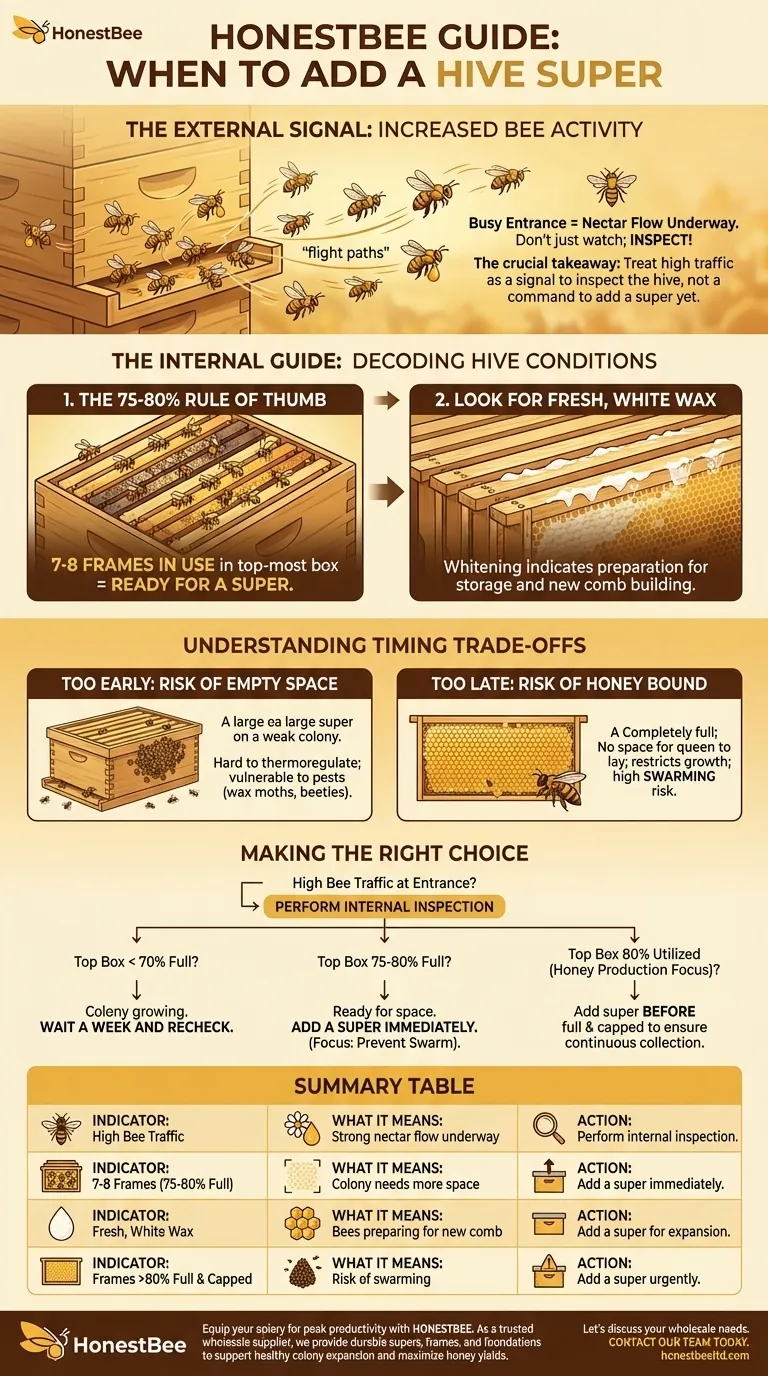In short, increased bee activity at the hive entrance is a strong external indicator that a nectar flow is underway. When you see a significant rise in the number of bees coming and going, it means they are successfully foraging and bringing back large quantities of nectar. This influx quickly fills available storage space, signaling that the colony will soon need a super to store the surplus honey.
The crucial takeaway is to treat high bee traffic not as a command, but as a signal to inspect the hive. The activity outside the hive tells you what is happening (a nectar flow), but the conditions inside tell you when it's the right time to act.

Decoding the Signals at the Hive Entrance
Observing the entrance to your hive provides valuable, real-time data about the colony's health and the resources available in your local environment. Understanding these cues is the first step in effective hive management.
What "Increased Activity" Looks Like
This isn't just a few more bees. A true signal is a noticeable and sustained increase in the number of foraging bees flying in and out of the hive. It often looks like a bustling airport, with clear "flight paths" of bees arriving and departing.
The Underlying Cause: A Strong Nectar Flow
This heightened traffic directly corresponds to a "nectar flow," a period when one or more major floral sources are producing abundant nectar. The bees are capitalizing on this temporary bounty, and their frenzied activity is a direct reflection of resource availability.
Why an Internal Inspection is Non-Negotiable
While the activity at the entrance is a vital clue, the definitive answer for when to add a super lies inside the hive. Acting on external signs alone can lead to mistakes.
The 75-80% Rule of Thumb
The most reliable indicator is frame usage. Open the hive and look at the top-most box. When the bees have drawn out comb and are actively using 7 to 8 of the 10 frames (for brood, pollen, or nectar), it is time to add a super.
This shows they have nearly exhausted their current space and are ready to expand upwards.
Look for Fresh, White Wax
Another key internal sign is "whitening." When bees are preparing to store a large nectar surplus, they produce new wax. You will see fresh, white wax being built up along the top edges of the frames, which indicates they are ready and able to build new comb.
Understanding the Trade-offs of Timing
Timing is everything in beekeeping. Adding a super is not just about giving bees more space; it's about giving it to them at the moment they need it.
The Risk of Adding a Super Too Early
If you add a super before the colony is strong enough to occupy it, you create a large, empty space. This makes it much harder for the bees to thermoregulate the brood nest and defend the hive from pests like wax moths or small hive beetles.
The Risk of Adding a Super Too Late
Waiting too long can have more severe consequences. The colony can become "honey bound," meaning the queen runs out of cells to lay eggs in because the bees have filled them with nectar. This severely restricts colony growth and is a primary trigger for swarming.
Making the Right Choice for Your Colony
Use external activity as your cue to check, and internal conditions as your final guide.
- If your primary focus is preventing a swarm: Add a super as soon as the top box reaches that 75-80% capacity, especially if you see heavy bee traffic.
- If your primary focus is maximizing honey production: Do not wait until the existing frames are completely full and capped; add the super when they are 80% utilized to ensure the bees never stop collecting.
- If you see high traffic but the top box is less than 70% full: The colony is growing but not yet ready for more space. Wait a week and check again.
Ultimately, learning to read your bees' signals empowers you to support their natural cycle and ensure a healthy, productive hive.
Summary Table:
| Indicator | What It Means | Action to Take |
|---|---|---|
| High Bee Traffic at Entrance | A strong nectar flow is likely underway. | Perform an internal hive inspection. |
| 7-8 Frames in Use (75-80% Full) | The colony is ready for more space. | Add a super immediately. |
| Fresh, White Wax on Frames | Bees are preparing to build new comb for storage. | Add a super to support expansion. |
| Frames >80% Full & Capped | Risk of becoming honey-bound; high swarming risk. | Add a super urgently to prevent swarming. |
Equip your apiary for peak productivity with HONESTBEE.
Managing a strong nectar flow requires reliable, high-quality equipment. As a trusted wholesale supplier to commercial apiaries and beekeeping equipment distributors, HONESTBEE provides the durable supers, frames, and foundations your operation needs to support healthy colony expansion and maximize honey yields.
Let's discuss your wholesale needs. Contact our team today to get the right equipment for your beekeeping success.
Visual Guide

Related Products
- In-Hive Dual Compartment Frame Bee Feeder for Targeted Colony Nutrition
- HONESTBEE Professional Entrance Bee Feeder Hive Nutrition Solution
- Wooden Bee Brush with Double-Row Horsehair Bristles
- Plastic Handle Single Row Artificial Fiber Bee Brush
- High-Efficiency Diamond Maze Bee Escape for Clearing Supers
People Also Ask
- What strategy was used to eliminate summer migration in the Sierra foothills? Proactive Feeding Based on Brood Signals
- How does the internal feeder method work? Protect Your Hive from Robbing and Cold
- When is sugar syrup typically fed to bees? A Guide to Strategic Feeding for Strong Hives
- What are the benefits of feeding bees inside the hive? Maximize Colony Health & Security
- What precautions should be taken when feeding bees inside the hive? Safeguard Your Colony from Robbing and Leaks



















